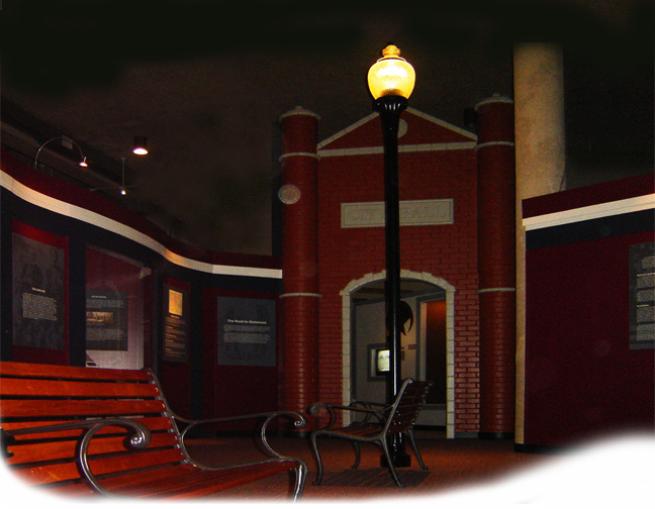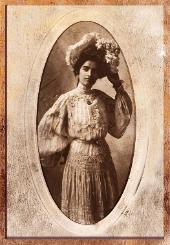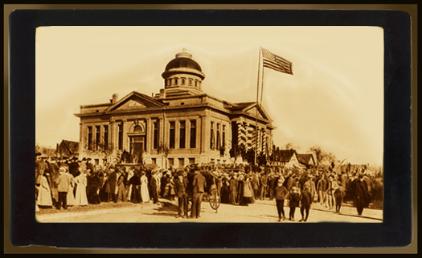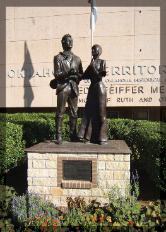

406 EAST OKLAHOMA AVENUE
GUTHRIE, OKLAHOMA 73044
405.282.1889









G A L L E R Y
On Statehood Day, November 16, 1907,
Charles N. Haskell became the first
governor of the new State of Oklahoma
He was inaugurated on the steps of
Guthrie's Carnegie Library, now part
of the Guthrie Museum Complex and
one of Guthrie's many buildings
included on the National Register
of Historic Places.
Charles N. Haskell became the first
governor of the new State of Oklahoma
He was inaugurated on the steps of
Guthrie's Carnegie Library, now part
of the Guthrie Museum Complex and
one of Guthrie's many buildings
included on the National Register
of Historic Places.
| View of the 46th Star Flag presented to Oklahoma in 1908 by the City of Philadelphia |
The Great Seal of the
State of Oklahoma,
rumored to have been
"stolen" by Oklahoma
City was in fact legally
removed from the
Logan County
Courthouse by
Governor Haskell's
Secretary, William
Anthony, after a
vote of the people in
1910 designated
OKC as the
permanent capital.
As a gesture of good
will, Governor Brad
Henry graciously
returned the seal to
Guthrie for the
Oklahoma Centennial
Celebration in 2007.
Currently it is on
display once again
at the state capitol
in Oklahoma City.
State of Oklahoma,
rumored to have been
"stolen" by Oklahoma
City was in fact legally
removed from the
Logan County
Courthouse by
Governor Haskell's
Secretary, William
Anthony, after a
vote of the people in
1910 designated
OKC as the
permanent capital.
As a gesture of good
will, Governor Brad
Henry graciously
returned the seal to
Guthrie for the
Oklahoma Centennial
Celebration in 2007.
Currently it is on
display once again
at the state capitol
in Oklahoma City.
FOR THE RECORD...
Partisan politics and legal battles were as much a part of
Oklahoma's struggle for statehood as was the deep desire
to be a part of the United States with all its benefits and
responsibilities.
There were several plans for statehood including a two state
plan to create the State of Sequoyah from Indian Territory and the
State of Oklahoma from Oklahoma Territory. The US government
finally, after much squabbling, decreed that there would be only
one state which would include both territories and be called
Oklahoma. This was called the Oklahoma Enabling Act and it
directed the "marriage" of the two territories and called for
Guthrie to be the capital until 1913.
Republicans had controlled Guthrie since 1890 but this would
dramatically change during the constitutional convention in 1907.
Of the 112 delegates elected to write the constitution, 99 were
Democrats and one was an independent who joined with the
Democrats on almost every issue. Only 12 Republicans were
left in power. Charles Haskell was named as secretary and
William "Alfalfa Bill" Murray was named
as president of the convention.
There were provisions on numerous
issues including liquor prohibition,
women's suffrage that although
became law did not make it into
the document. Still, and to this day
the longest state constitution in
the US was finally ratified. On
November 16, 1907, amid much
celebration, Oklahoma became
the 46th state in the United States.
Oklahoma's struggle for statehood as was the deep desire
to be a part of the United States with all its benefits and
responsibilities.
There were several plans for statehood including a two state
plan to create the State of Sequoyah from Indian Territory and the
State of Oklahoma from Oklahoma Territory. The US government
finally, after much squabbling, decreed that there would be only
one state which would include both territories and be called
Oklahoma. This was called the Oklahoma Enabling Act and it
directed the "marriage" of the two territories and called for
Guthrie to be the capital until 1913.
Republicans had controlled Guthrie since 1890 but this would
dramatically change during the constitutional convention in 1907.
Of the 112 delegates elected to write the constitution, 99 were
Democrats and one was an independent who joined with the
Democrats on almost every issue. Only 12 Republicans were
left in power. Charles Haskell was named as secretary and
William "Alfalfa Bill" Murray was named
as president of the convention.
There were provisions on numerous
issues including liquor prohibition,
women's suffrage that although
became law did not make it into
the document. Still, and to this day
the longest state constitution in
the US was finally ratified. On
November 16, 1907, amid much
celebration, Oklahoma became
the 46th state in the United States.
Though Guthrie had been designated by the Enabling
Act to remain the capital until 1913, the power of
political pressure from Oklahoma City was great.
It was already larger than Guthrie and despite the
promises, a referendum was called for and in 1910,
Oklahoma City, won and the capital was moved. This left
Guthrie on its own without status and it wasn't until the
1980's that the vast treasure trove of architecture and
rich history was brought to the forefront. Careful
restoration and preservation has made Guthrie the jewel
in the crown of Oklahoma history and brings thousands of
visitors every year to see the splendid Victorian "era"
architecture that was the hallmark of the new state.
Our Statehood Gallery holds many artifacts and treasures
that were relevant to the convention, to the process of
statehood and to the history of Guthrie.
Act to remain the capital until 1913, the power of
political pressure from Oklahoma City was great.
It was already larger than Guthrie and despite the
promises, a referendum was called for and in 1910,
Oklahoma City, won and the capital was moved. This left
Guthrie on its own without status and it wasn't until the
1980's that the vast treasure trove of architecture and
rich history was brought to the forefront. Careful
restoration and preservation has made Guthrie the jewel
in the crown of Oklahoma history and brings thousands of
visitors every year to see the splendid Victorian "era"
architecture that was the hallmark of the new state.
Our Statehood Gallery holds many artifacts and treasures
that were relevant to the convention, to the process of
statehood and to the history of Guthrie.

During the Statehood
festivities a mock"marriage"
took place on the steps of
the Carnegie Library
between Miss Indian
Territory and
Mr. Oklahoma Territory
festivities a mock"marriage"
took place on the steps of
the Carnegie Library
between Miss Indian
Territory and
Mr. Oklahoma Territory
Replicas of the symbolic
wedding dress and the
inagural dress worn by
Mrs. Charles Haskell.
wedding dress and the
inagural dress worn by
Mrs. Charles Haskell.
Activist Kate Barnard, fought
for mandatory education
and prison reform during
the writing of the Oklahoma
constitutional convention
She was also Oklahoma's
first female state official.
for mandatory education
and prison reform during
the writing of the Oklahoma
constitutional convention
She was also Oklahoma's
first female state official.
Territorial Seal
| Embroidered star from the 46th Star Flag |